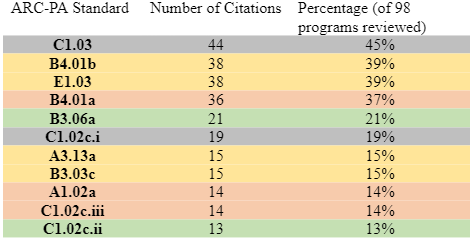Upcoming Dr. Scott Massey Webinar: The most common ARC-PA citations

As a full-time consultant for PA schools and their administrators, I work with my clients daily to ensure that their program complies with ARC-PA standards and receives a positive Commission action following a site visit. My ability to see trends over time gives me insight into best preparing my clients for these visits and any necessary remedies.
At Dr. Scott Massey https://drscottmassey.com/ , we are preparing a new free webinar series in which I will explore each of the top ten citations that PA programs receive, providing mitigating strategies to demonstrate compliance to the Standards more effectively.
Most common citations
I would be remiss if I didn't express concerns about the increased number of programs that have received probation. Forty-four programs have been reviewed by the ARC-PA in 2023, eleven of which programs (25%) received Accreditation-Probation status. Perhaps this provides a glimpse into ARC-PA’s expectations regarding demonstrating compliance.
However, a noticeable number of the probation-status programs are not provisional but previously continued-status. I see two overarching patterns:
- The fact that four out of the top ten citations are related to assessment provides a glimpse into heightened expectations. Assessment now must be an integral part of the operations of a PA program. Gone are the days when having a biannual or annual retreat is sufficient to meet these requirements. The manner in which you write the Self Study Report will determine the level of compliance perceived.
- A combination of standards B 4.01a, B 4.01b, and B 3.03 as three out of the ten most common citations underscores the importance of having a concise assessment of didactic and clinical year learning outcomes, including a system of gap analysis to ensure that all clinical learning outcomes triangulate accurately with assessment modalities and assurance that all learning outcomes are met before the conclusion of the clinical year.
The following chart narrows down the ten top-cited Standards and the percentage of programs to receive the citation. Since the number of programs was close to 100, you will see that the number of citations and the rounded percentage are quite close.

Webinar breakdown
During the upcoming webinar series, I will dive deeper into each of these ten citations. Because of the depth and breadth of these issues, I will divide the webinar series into two parts, each with three webinars dealing with specific statutes, as follows:
Series Part 1
Webinar 1
Statute C1.03. The program must prepare a self-study report as part of the application for accreditation that accurately and succinctly documents the process, application and results of ongoing program self-assessment. The report must follow the guidelines provided by the ARC-PA.
Webinar 2
Statute C1.02c.i. The program must implement its ongoing self-assessment process by: c) applying the results leading to conclusions that identify: i. program strengths.
Webinar 3
Statute C1.02c.ii. The program must implement its ongoing self-assessment process by: c) applying the results leading to conclusions that identify: ii. program areas in need of improvement.
Statute C1.02c.iii. The program must implement its ongoing self-assessment process by: c) applying the results leading to conclusions that identify: iii. action plans.
Series Part 2
Webinar 4
Statute B3.06a: Supervised clinical practice experiences should occur with: a) physicians who are specialty board certified in their area of instruction.
Statute B3.03c: Supervised clinical practice experiences must enable all students to meet the program’s learning outcomes: c) for women’s health (to include prenatal and gynecologic care),
Webinar 5
Statute B4.01a /B4.01b: The program must conduct frequent, objective and documented evaluations of student performance in meeting the program’s learning outcomes and instructional objectives for both didactic and supervised clinical practice experience components. The evaluations must: a) align with what is expected and taught and b) allow the program to identify and address any student deficiencies in a timely manner
Webinar 6
Statute A1.02a: The sponsoring institution is responsible for: a) supporting the planning by program faculty of curriculum design, course selection, and program assessment
Statute A3.13a: The program must define, publish, consistently apply and make readily available to prospective students, policies and procedures to include: a) admission and enrollment practices that favor specified individuals or groups (if applicable),
Statute E1.03. The program must submit reports or documents as required by the ARC-PA.
Conclusion
I have seen the anxiety expressed by PA faculty and program directors about preparation for upcoming ARC-PA visits. This is why I believe a preventative approach is so paramount, particularly for programs entering the validation visit for the first time since the 5th Edition Standards were incorporated. I encourage you to attend our upcoming webinar to begin your program’s preventative approach. Remember, Dr. Scott Massey webinars are always free! I hope to see you there, and also in the next issue of our blog.

